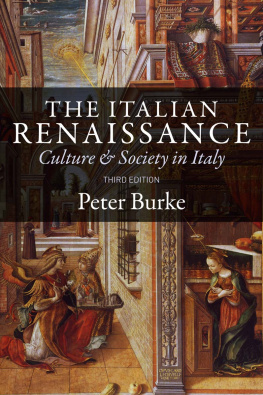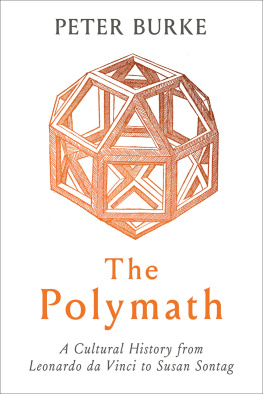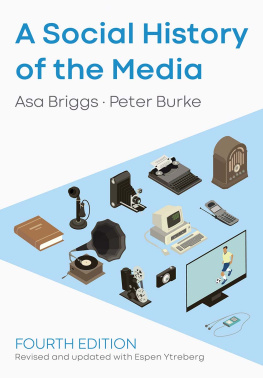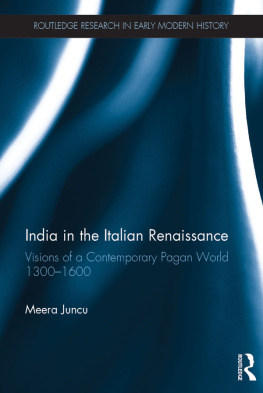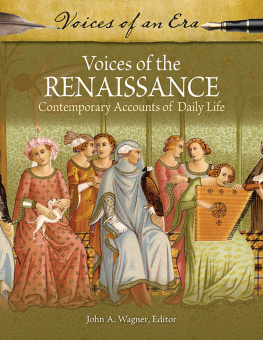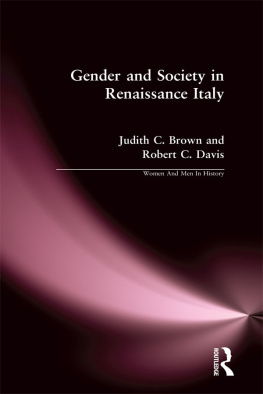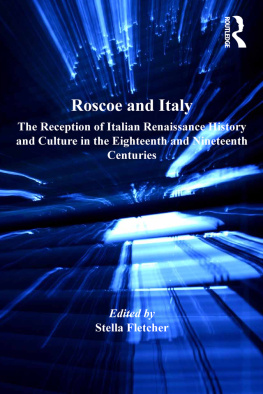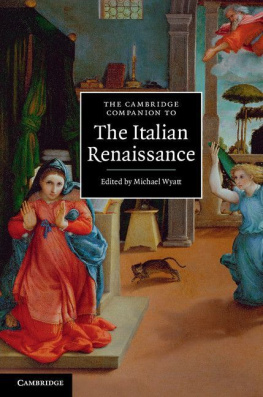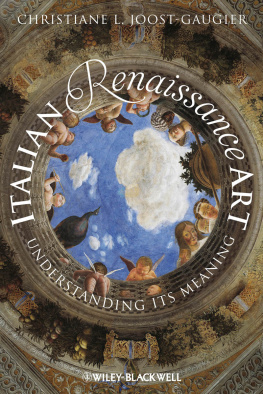THE ITALIAN RENAISSANCE
For Maria Lcia
Copyright Peter Burke 1986, 1999, 2014
First edition 1972 by Batsford, UK. Scribner, US. Paperback edition published by Collins Fontana 1974. Revised edition first published 1987 by Polity Press in association with Blackwell Publishers Ltd. Reprinted in 1988, 1991, 1993, 1994
Revised second edition first published 1999.
Reprinted in 2000, 2003, 2004, 2005, 2006, 2010.
This revised third edition first published 2014.
Polity Press
65 Bridge Street
Cambridge CB2 1UR, UK
All rights reserved. Except for the quotation of short passages for the purposes of criticism and review, no part of this publication may be reproduced, stored in a retrieval system, or transmitted, in any form or by any means, electronic, mechanical, photocopying, recording or otherwise, without the prior permission of the publisher.
Except in the United States of America, this book is sold subject to the condition that it shall not, by way of trade or otherwise, be lent, re-sold, hired out, or otherwise circulated without the publishers prior consent in any form of binding or cover other than that in which it is published and without a similar condition including this condition being imposed on the subsequent purchaser.
ISBN 978-0-7456-7967-9
A CIP catalogue record for this book is available from the British Library.
Image nos. 15, 8, 1112, 1622, 246, 2932, 346 Wikimedia Commons; 67 by permission of Cambridge University Library; 9, Musei Vaticani; 10, Fabbrica di San Pietro in Vaticano; 13, Photgraph by James Austin; 14, St Bernard preaching, by Francesco di Giorgio e di Lorenzo known as the Elder (Vecchietta) (ca 14121480), Detail / De Agostini Picture Library / The Bridgeman Art Library; 15, Galleria Estense, Modena; 23, Musee Jacquemart-Andre, Paris (Photographie Bulloz); 27, Two studies of a man suspended by his left leg (red chalk on cream paper), Sarto, Andrea del (14861530) / Chatsworth House, Derbyshire, UK / Devonshire Collection, Chatsworth / Reproduced by permission of Chatsworth Settlement Trustees / The Bridgeman Art Library; 28 & 33, Getty Images.
For more information about polity please go to our website, www.politybooks.com
CONTENTS

Illustrations

INTRODUCTION

THE THEME
T his book is a history of the culture of the Italian Renaissance in a period (roughly 14001550) in which contemporaries claimed that art and literature was reborn. Paradoxical as it may seem, the Renaissance movement was a systematic attempt to go forward by going back in other words, to break with medieval tradition by following an older model, that of the ancient Greeks and Romans.
Hundreds if not thousands of studies have been devoted to this topic. The most famous of them remains The Civilization of the Renaissance in Italy (1860) by the great Swiss historian Jacob Burckhardt. Writing over a hundred and fifty years ago, Burckhardt viewed the Renaissance as a modern culture created by a modern society. Today, it looks rather more archaic. This shift in attitude is due in part to scholarly research on continuities between the Renaissance and the Middle Ages, but even more to changes in conceptions of the modern. Since 1860 the classical tradition has withered away, the tradition of representational art has been broken, and rural societies have become urban and industrial (if not post-industrial) on a scale that dwarfs fifteenth- and sixteenth-century cities and their handicrafts. Renaissance Italy now looks underdeveloped, in the sense that the majority of the population worked on the land, while many were illiterate and all of them were dependent on animate sources of power, especially horses and oxen. This perspective makes the many cultural innovations of the period even more remarkable than they seemed in Burckhardts time. To understand and explain these innovations, which came in the course of time to constitute a new tradition, is the aim of this book.
The perspective
The aim of the present study is to write not only a cultural history but also a social history of the Renaissance movement, and in particular to Neither of the key terms is easy to define. By culture I mean essentially attitudes and values and their expressions and embodiments in artefacts (including texts) and practices (including performances). Culture is the realm of the imaginary and the symbolic, not distinct from everyday life but underlying it. As for society, the term is shorthand for economic, social and political structures, all of which reveal themselves in the social relationships characteristic of a particular place and time.
The central argument of this book is that we cannot understand the culture of the Italians in this period if we look only at the conscious intentions of the individuals who produced the painting, sculpture, architecture, music, literature and philosophy that we continue to admire today. Understanding these individual intentions, so far as this remains possible after five hundred years hampered as we now are not only by gaps in the evidence but also by the differences between our categories, assumptions and values and theirs is certainly necessary, but it is not sufficient for the understanding of the movement in which these individuals participated.

